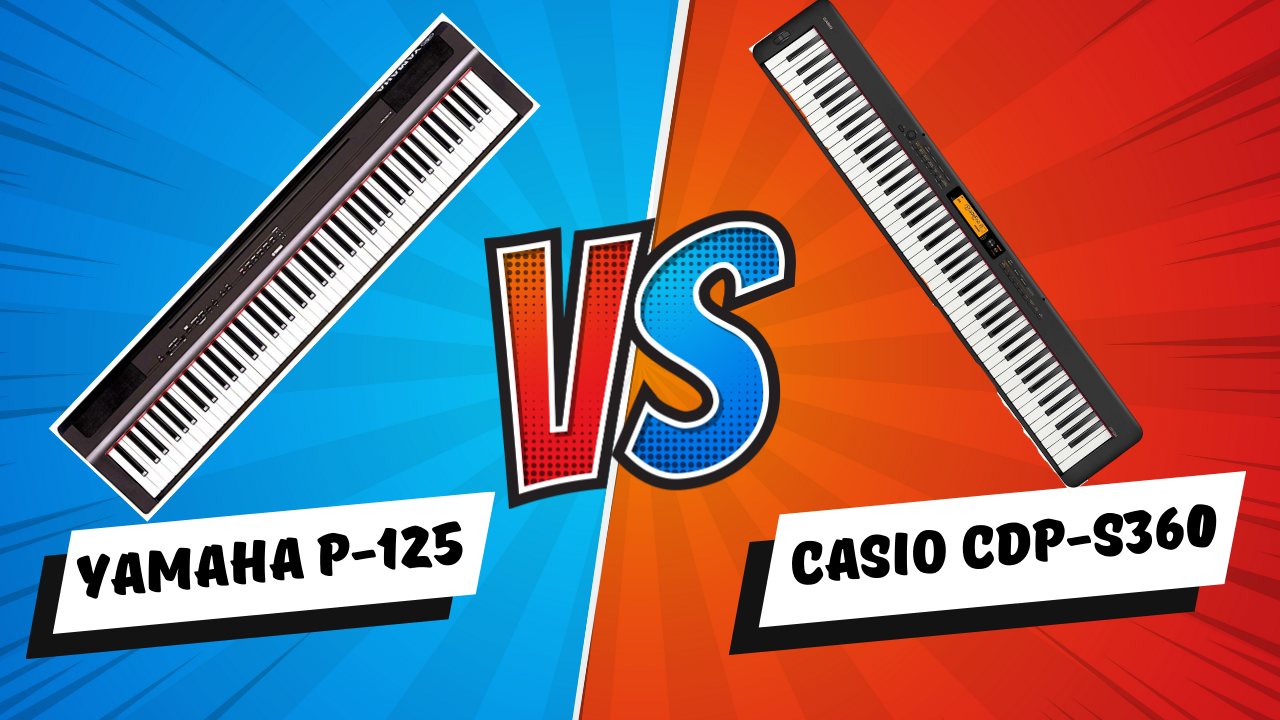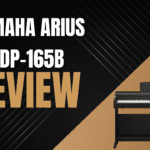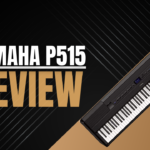Hey there, piano enthusiasts! 🎹 If you’re in the market for a new digital piano, you’ve come to the right place. Today, we’re going to dive into a battle of the titans: the Casio CDP-S360 versus the Yamaha P125. Yes, that’s right! We’ll be comparing these two popular instruments to help you make an informed decision.
I’ve played it all, from concert grands to tiny small pianos, and I’m here to share my knowledge with a sprinkle of humour and a dash of creativity. So, buckle up and let’s get started! We’ve got a lot to cover, so let’s briefly introduce our contenders. The Casio CDP-S360 is a versatile and portable digital piano with a slim design and a plethora of features.
It’s perfect for beginners and intermediate players alike. On the other hand, the Yamaha P125 is known for its authentic piano feel and exceptional sound quality, making it a favorite among many musicians. Our mission today is to examine these two instruments in-depth, comparing their design, key action, sound quality, features, and prices.
We’ll be looking at the pros and cons of each to determine which one offers the best value for your hard-earned money.
So, whether you’re searching for the best beginner keyboard under $300, the best digital piano under $700, the best digital piano for beginners under $500, or the best digital pianos for under $1000, we’ve got you covered! Now, let the Casio vs. Yamaha showdown begin! 🥊
| Feature | Casio CDP-S360 | Yamaha P125 |
|---|---|---|
| Design | Sleek, slim, and portable | Minimalist, compact, and portable |
| Build Quality | Sturdy construction, lightweight | Solid construction, slightly heavier |
| Key Action | Scaled Hammer Action II keyboard | Graded Hammer Standard (GHS) keyboard |
| Touch Sensitivity | 3 levels of adjustment | Adjustable touch sensitivity |
| Sound Quality | Multi-dimensional Morphing AiR Sound Source | Pure CF Sound Engine |
| Built-in Tones/Voices | 700 tones | 24 voices |
| Rhythms | 200 rhythms | N/A |
| Sound Customization | Layer and split functions | Layer and split functions |
| App Compatibility | Chordana Play app | Smart Pianist app |
| Connectivity | USB port, audio in, pedal ports, headphone jacks | USB-to-Host port, pedal ports, headphone jacks, aux out |
| Learning Tools | Chordana Play app compatibility | Smart Pianist app compatibility |
| Additional Features | Backlit LCD screen, pitch bend wheel, auto-accompaniment | Built-in metronome, song recorder |
| Price Range | Mid-range | Mid-range |
Design and Build Quality
Let’s kick things off with a look at the design and build quality of these two digital piano giants, shall we? After all, nobody wants a piano that looks like it’s about to fall apart or one that wouldn’t even win a beauty contest against a 1980s Casio calculator watch. 😜
| View on Amazon | Keys | Width | Depth | Height | Weight |
 | 88 | 52" | 9.1" | 3.9" | 24 lbs |
 | 88 | 52.2" | 11.9" | 6.5" | 26 lbs |
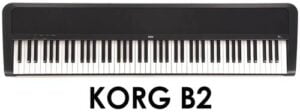 | 88 | 51.6" | 13.2" | 4.6" | 25.1 lbs |
 | 88 | 50.5" | 10.1" | 5.5" | 27.1 lbs |
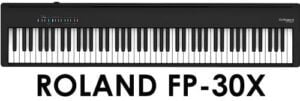 | 88 | 51.2" | 11.2" | 6" | 32.6 lbs |
 | 88 | 52.2" | 11.6" | 6.0" | 25.4 lbs |
 | 88 | 52" | 9.1" | 4" | 24.7 lbs |
Casio CDP-S360
First up, the Casio CDP-S360: this sleek and slim digital piano has a modern design that’ll blend seamlessly into any living space.

It boasts a compact, lightweight build, which makes it perfect for musicians on the go. Casio clearly had portability in mind when designing this instrument, and it shows.
Pros:
- Slim, stylish design
- Lightweight and portable
- Sturdy construction
Cons:
- Not as robust as some other digital pianos
- Limited onboard controls
Yamaha P125
Now, let’s move on to the Yamaha P125. Yamaha has a reputation for building solid, reliable instruments, and the P125 is no exception. Its minimalist design is both functional and attractive, with an emphasis on durability and performance.

The P125 has a bit more weight to it than the CDP-S360, but that’s to be expected given its focus on sound quality and key action.
Pros:
- Minimalist, elegant design
- Robust and durable construction
- Easy-to-navigate controls
Cons:
- Heavier than the CDP-S360
- Bulkier, less portable
When it comes to design and build quality, both pianos have their merits. If portability and style are your top priorities, the Casio CDP-S360 might be the one for you. However, if you’re more concerned about durability and a minimalist design, the Yamaha P125 is a strong contender.
But, don’t make up your mind just yet! We’ve still got plenty to discuss, so let’s move on to the key action and feel of these two digital pianos. 🎹
Key Action and Feel
Alright, folks! Now that we’ve covered design and build quality, it’s time to get our hands dirty (not literally, of course 😅) and dive into the world of key action and feel. After all, what good is a piano if it doesn’t feel right when you play it?
Casio CDP-S360
The Casio CDP-S360 is equipped with Casio’s Scaled Hammer Action II keyboard. This key action simulates the feel of an acoustic piano by using a graded hammer system, meaning the lower keys have a heavier touch while the higher keys are lighter.

It’s a great feature, especially for those who want an authentic piano experience on a budget.
Pros:
- Scaled Hammer Action II keyboard for realistic feel
- Touch sensitivity with three levels of adjustment
- Comfortable key surface
Cons:
- Key action may feel lighter than some acoustic pianos
- Some players might prefer a more substantial key resistance
Yamaha P125
The Yamaha P125, on the other hand, features the Graded Hammer Standard (GHS) keyboard. Similar to Casio’s offering, the GHS keyboard provides a graded hammer action that mimics the feel of an acoustic piano.

Many players find the Yamaha’s key action to be slightly more realistic than the Casio’s, although this is subjective and may vary from person to person.
Pros:
- Graded Hammer Standard keyboard for authentic feel
- Adjustable touch sensitivity
- Generally regarded as having a more realistic key action
Cons:
- Keys may feel somewhat noisy during fast passages
- Some players may still find the key action too light compared to acoustic pianos
Both the Casio CDP-S360 and Yamaha P125 offer a solid key action and feel, with each providing a graded hammer action for that authentic piano experience. While some players may prefer the Yamaha’s slightly more realistic key action, it ultimately comes down to personal preference.
So, make sure to try both out before making a decision. But wait! We’re not done yet; let’s proceed to the sound quality comparison, shall we? 🎶
Sound Quality
Ah, sound quality! The pièce de résistance of any musical instrument, especially digital pianos. After all, no matter how good a piano looks or feels, it’s the sound that’ll truly make your heart sing (or not). So, let’s dive into the sonic characteristics of the Casio CDP-S360 and the Yamaha P125 and see which one hits the right notes. 🎼
Casio CDP-S360
Casio has come a long way in recent years, and the CDP-S360 is proof of their improvements in sound quality. This digital piano is equipped with Casio’s Multi-dimensional Morphing AiR Sound Source, which provides a rich and expressive tone. With 700 built-in tones, you’ll have a wide array of sounds to choose from, including some impressive electric pianos and organs. Pros:
- Multi-dimensional Morphing AiR Sound Source
- 700 built-in tones for versatility
- Layer and split functions for sound customization
Cons:
- Some tones may not be as realistic as Yamaha’s offerings
- Piano sound may lack the warmth and depth of Yamaha’s Pure CF Sound Engine
Yamaha P125
Yamaha is renowned for its sound quality, and the P125 doesn’t disappoint. This digital piano boasts the Pure CF Sound Engine, which reproduces the meticulously sampled sound of Yamaha’s famed CFIIIS concert grand piano.
The result is an incredibly authentic and expressive piano sound. With 24 built-in voices, the P125 may not have as many options as the CDP-S360, but it makes up for it with the realism of its core piano sounds.
Pros:
- Pure CF Sound Engine for realistic and expressive piano sound
- 24 high-quality built-in voices
- Rich, warm, and powerful piano tone
Cons:
- Fewer built-in voices compared to Casio CDP-S360
- Some players may want more sound customization options
When it comes to sound quality, both pianos have their strengths. The Casio CDP-S360 offers a wide variety of tones and the flexibility to layer and split sounds, while the Yamaha P125 excels in delivering a rich, warm, and authentic piano sound.
Your preference will depend on whether you prioritize versatility or the pure quality of the core piano sound. But don’t jump to conclusions just yet! We still have features and price to compare, so let’s keep going. 🎹
Features
In this day and age, features can be a real game-changer when it comes to digital pianos. From connectivity options to learning tools, the right set of features can make all the difference in your playing experience. So, let’s see what the Casio CDP-S360 and Yamaha P125 have to offer in this department. 🎚️
Casio CDP-S360
The Casio CDP-S360 is like a Swiss Army knife when it comes to features. With 700 built-in tones, 200 rhythms, and a backlit LCD screen, this digital piano is ready for anything. It also includes a pitch bend wheel, a USB port, and an auto-accompaniment function, giving you plenty of creative options. In addition, the CDP-S360 is compatible with Casio’s Chordana Play app, which allows you to learn and practice songs using your smartphone or tablet.
Pros:
- 700 tones and 200 rhythms for creative exploration
- Backlit LCD screen for easy navigation
- Chordana Play app compatibility for learning and practice
- USB connectivity and pitch bend wheel
Cons:
- Some features might be overwhelming for beginners
- App compatibility may vary depending on the device
Yamaha P125
The Yamaha P125 might not be as feature-packed as the CDP-S360, but it still has a solid set of features that cater to most players’ needs. It includes the Smart Pianist app, which allows you to control the piano and access sheet music from your iOS or Android device.
The P125 also offers a built-in metronome, a song recorder, and the ability to layer and split sounds. Plus, it comes with a USB-to-Host port for easy connectivity.
Pros:
- Smart Pianist app compatibility for enhanced control and learning
- Built-in metronome and song recorder
- Layer and split functions for sound customization
- USB-to-Host connectivity
Cons:
- Fewer built-in tones and rhythms compared to the Casio CDP-S360
- Some players might prefer more advanced features
In terms of features, the Casio CDP-S360 is the more versatile option, offering a vast array of tones, rhythms, and creative tools. However, the Yamaha P125 still provides a solid set of features for most players, with app compatibility and sound customization options.
Your choice will depend on whether you want a feature-rich instrument or a more streamlined, focused playing experience. But hold your horses! We’ve still got one more section to go – let’s talk price. 💰
Price
Finally, we’ve reached the all-important topic of price. After all, we all want to get the most bang for our buck, right? So, let’s take a look at the price tags on the Casio CDP-S360 and Yamaha P125 and see which one offers the best value for money. 💸
Casio CDP-S360
The Casio CDP-S360 is generally priced in the mid-range, making it an attractive option for those looking for a feature-rich instrument without breaking the bank.
Considering its wide array of tones, rhythms, and creative tools, the CDP-S360 offers excellent value for its price point, especially for beginners and intermediate players.
Yamaha P125
The Yamaha P125, on the other hand, falls within a similar price range as the Casio CDP-S360. While it may not offer as many features as the CDP-S360, it makes up for it with its exceptional sound quality and key action.
If you’re more concerned with the core piano-playing experience and are willing to sacrifice some extra features, the P125 might be a better value for your money. Both the Casio CDP-S360 and Yamaha P125 offer excellent value within their respective price ranges.
Your choice will ultimately depend on your priorities as a player. Do you want a feature-rich instrument with lots of creative options, or are you more focused on sound quality and key action? With that in mind, let’s wrap things up with a conclusion and personal recommendation. 🏁
Conclusion
We’ve reached the end of our musical adventure, comparing the Casio CDP-S360 and Yamaha P125, two popular digital pianos in the world of Casio and Yamaha instruments. Our journey took us through their design, build quality, key action, sound quality, features, and price. Now, it’s time to decide which digital piano is the perfect choice for you. 🤔
If versatility is your priority and you want a feature-rich digital piano with a wide range of tones, rhythms, and creative options, the Casio CDP-S360 is your go-to instrument. With a design comparable to some Roland instruments, this Casio piano offers great value for the price. On the flip side, if sound quality and key action top your list, the Yamaha P125 is an excellent choice.
Boasting a minimalist design and a sound quality comparable to some FPX series instruments, this digital piano offers a superb playing experience. Ultimately, the decision between the Casio CDP-S360 and Yamaha P125 comes down to your individual preferences and requirements as a musician.
Both digital pianos offer great value for money, so you can’t go wrong with either option. Our personal recommendation? Give both of these remarkable instruments a try and see which one strikes the right chord with your heart. After all, the best digital piano is the one that inspires you to play every day! 🎹🎶
FAQs
[toggle title=”Q: Are the Casio CDP-S360 and Yamaha P125 suitable for beginners?” state=”close”]
A: Yes, both digital pianos are suitable for beginners. They offer a realistic piano-playing experience with weighted key action, making them excellent choices for those starting their musical journey. The app compatibility on both pianos also provides learning tools for beginners to enhance their skills.[/toggle]
[toggle title=”Q: Can I connect external speakers to these digital pianos?” state=”close”]
A: Yes, both the Casio CDP-S360 and Yamaha P125 have options for connecting external speakers. The CDP-S360 has an audio input for connecting speakers, while the P125 features an auxiliary output for connecting external speakers or amplifiers.[/toggle]
[toggle title=”Q: Are these digital pianos portable?” state=”close”]
A: Both the Casio CDP-S360 and Yamaha P125 are designed with portability in mind. The CDP-S360 has a slim and lightweight design, making it easy to transport. The P125 is slightly heavier, but it still maintains a compact and portable design.[/toggle]
[toggle title=”Q: What kind of pedals can I use with these digital pianos?” state=”close”]
A: Both the Casio CDP-S360 and Yamaha P125 have ports for connecting sustain pedals. The CDP-S360 also supports an optional 3-pedal unit, the SP-34, while the P125 is compatible with the optional Yamaha LP-1 3-pedal unit.[/toggle]
[toggle title=”Q: Can I use headphones with the Casio CDP-S360 and Yamaha P125?” state=”close”]
A: Yes, both digital pianos have headphone jacks, allowing you to practice privately without disturbing others around you.[/toggle]

